SIT792 Minor Thesis: Non-Invasive Monitoring of Metabolic Disorders
VerifiedAdded on 2023/04/08
|7
|768
|354
Project
AI Summary
This project proposal investigates the application of non-invasive technologies for monitoring metabolic disorders, addressing the limitations of traditional, invasive methods. It highlights the use of smartphone applications, body-worn sensors, and data analytics for efficient health data collection and analysis. The proposal emphasizes the potential of biomimetic cross-reactive sensor arrays (B-CRSAs) and wearable sensors in early disease diagnosis and monitoring, specifically for metabolic by-products detectable in vapor, tears, saliva, and sweat. The research aims to explore the feasibility and benefits of these non-invasive techniques for improved patient care and personalized medicine. The project also outlines the research methodology and timeline for the study.
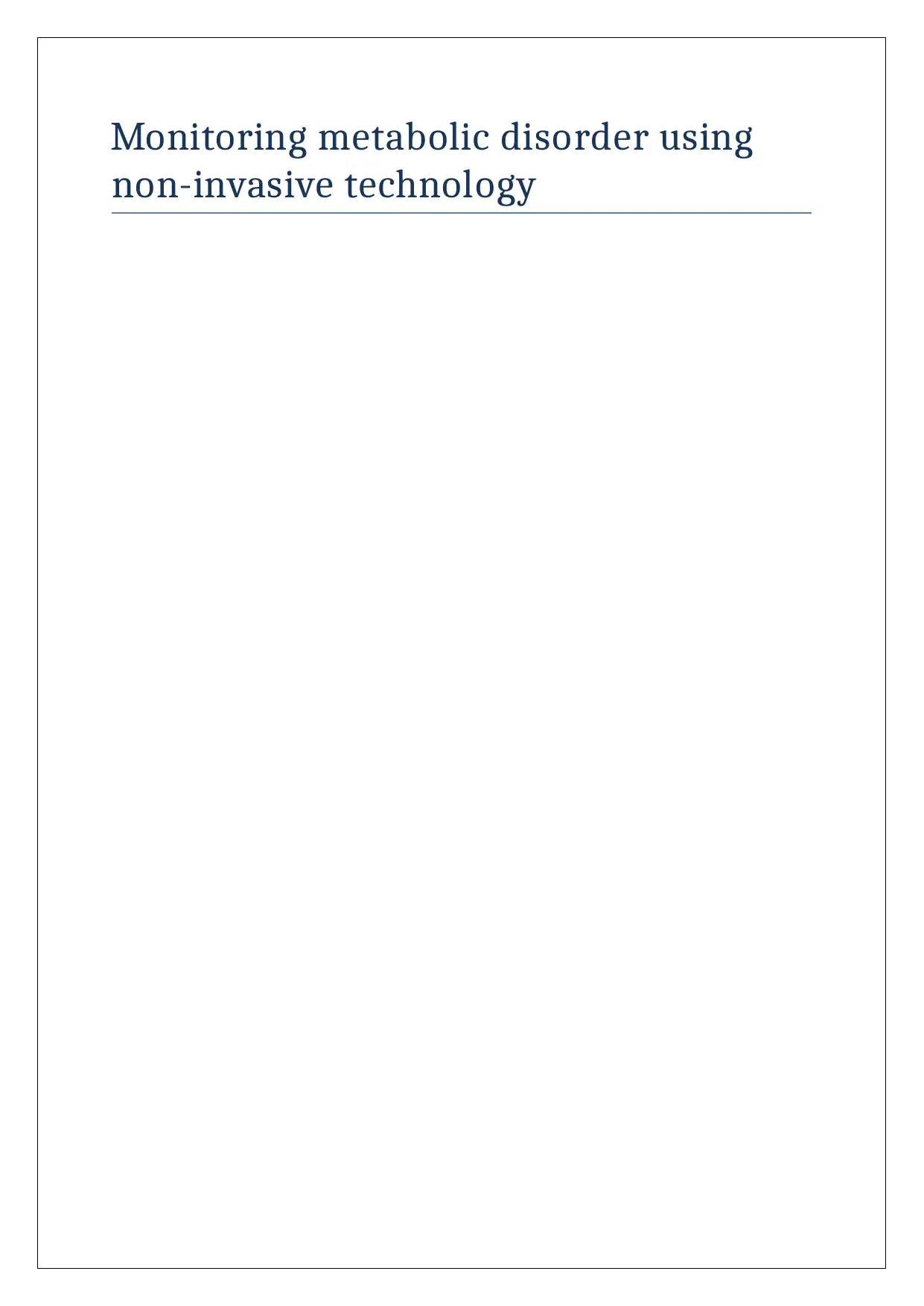
Monitoring metabolic disorder using
non-invasive technology
non-invasive technology
Paraphrase This Document
Need a fresh take? Get an instant paraphrase of this document with our AI Paraphraser
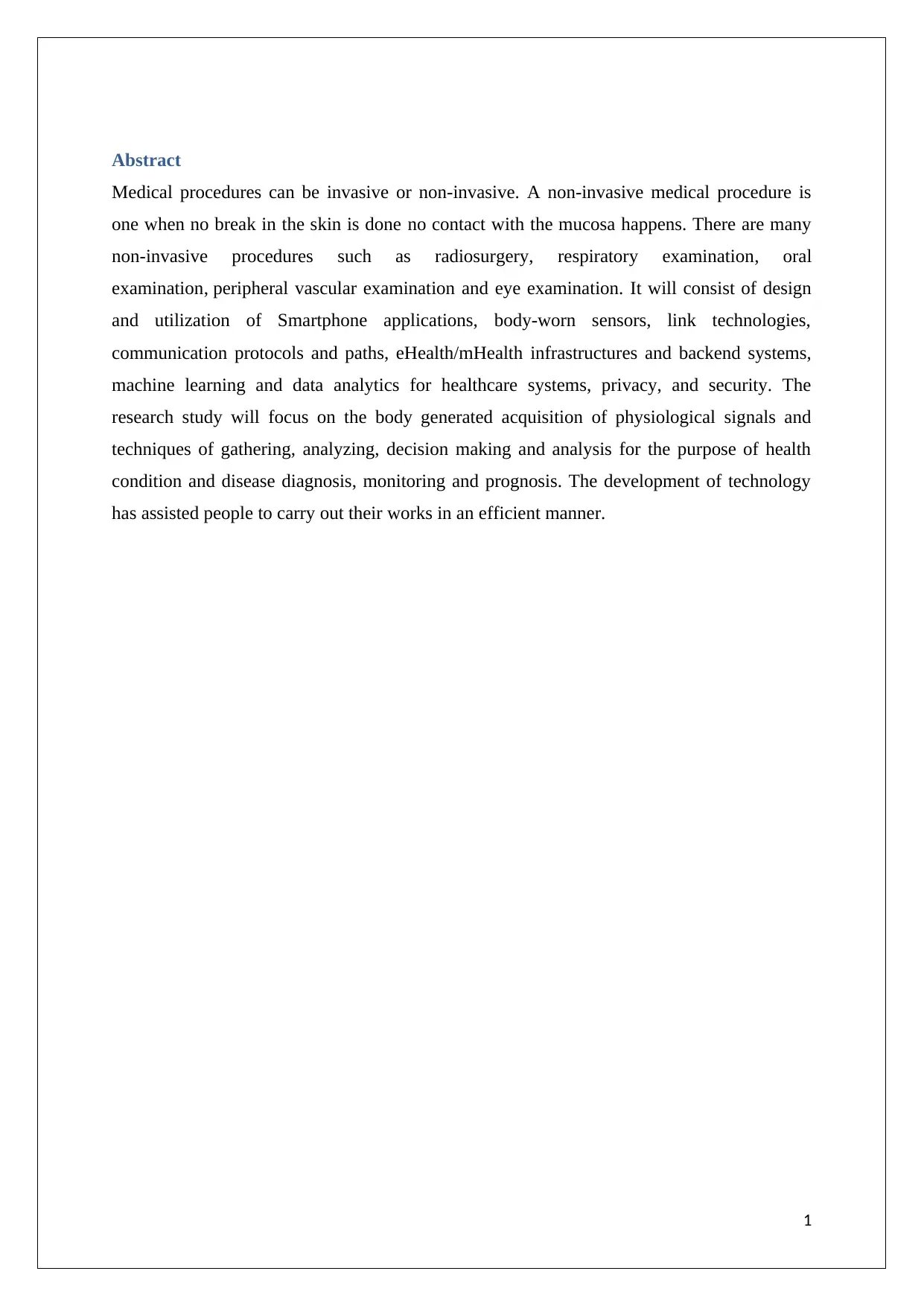
Abstract
Medical procedures can be invasive or non-invasive. A non-invasive medical procedure is
one when no break in the skin is done no contact with the mucosa happens. There are many
non-invasive procedures such as radiosurgery, respiratory examination, oral
examination, peripheral vascular examination and eye examination. It will consist of design
and utilization of Smartphone applications, body-worn sensors, link technologies,
communication protocols and paths, eHealth/mHealth infrastructures and backend systems,
machine learning and data analytics for healthcare systems, privacy, and security. The
research study will focus on the body generated acquisition of physiological signals and
techniques of gathering, analyzing, decision making and analysis for the purpose of health
condition and disease diagnosis, monitoring and prognosis. The development of technology
has assisted people to carry out their works in an efficient manner.
1
Medical procedures can be invasive or non-invasive. A non-invasive medical procedure is
one when no break in the skin is done no contact with the mucosa happens. There are many
non-invasive procedures such as radiosurgery, respiratory examination, oral
examination, peripheral vascular examination and eye examination. It will consist of design
and utilization of Smartphone applications, body-worn sensors, link technologies,
communication protocols and paths, eHealth/mHealth infrastructures and backend systems,
machine learning and data analytics for healthcare systems, privacy, and security. The
research study will focus on the body generated acquisition of physiological signals and
techniques of gathering, analyzing, decision making and analysis for the purpose of health
condition and disease diagnosis, monitoring and prognosis. The development of technology
has assisted people to carry out their works in an efficient manner.
1
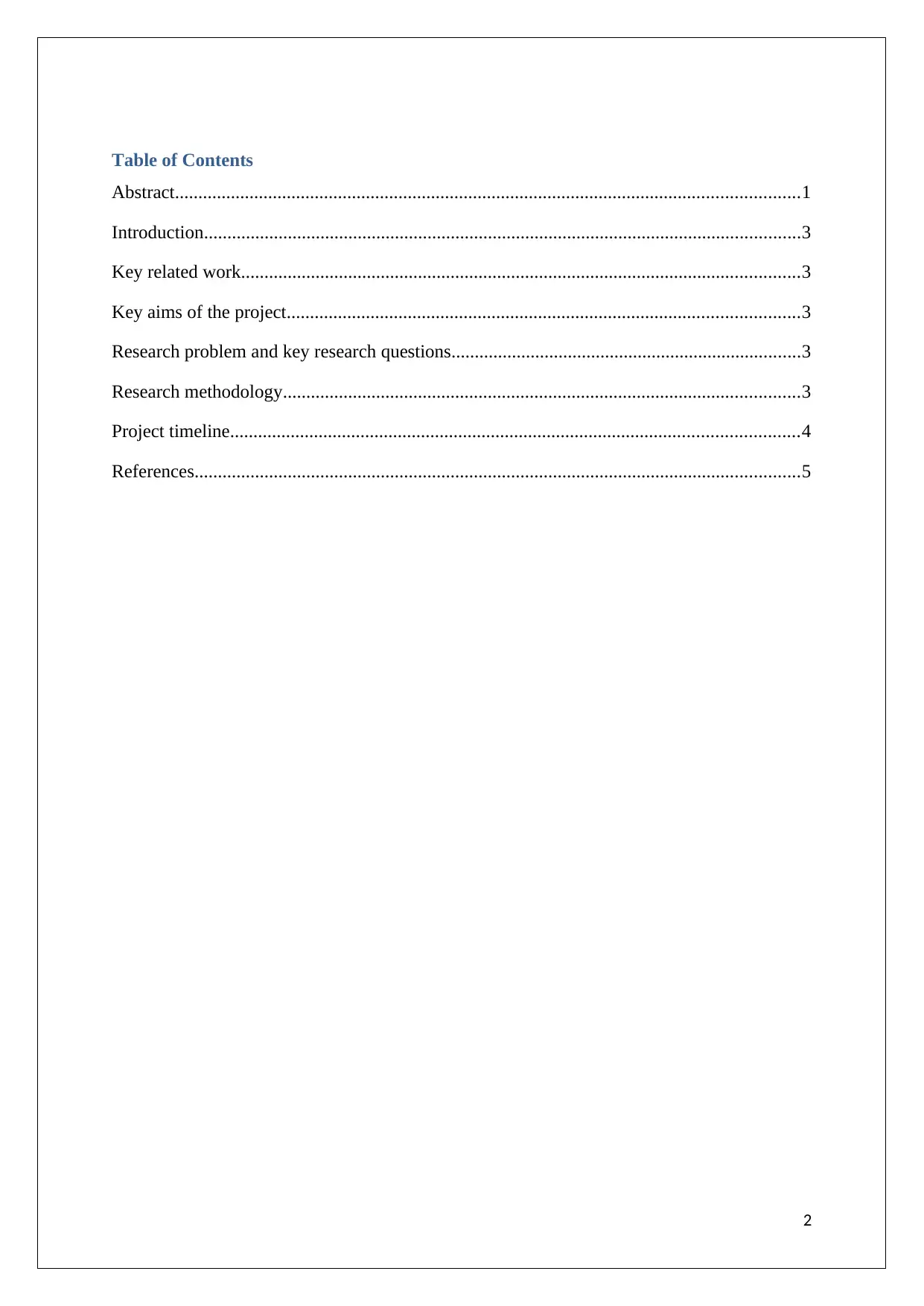
Table of Contents
Abstract......................................................................................................................................1
Introduction................................................................................................................................3
Key related work........................................................................................................................3
Key aims of the project..............................................................................................................3
Research problem and key research questions...........................................................................3
Research methodology...............................................................................................................3
Project timeline..........................................................................................................................4
References..................................................................................................................................5
2
Abstract......................................................................................................................................1
Introduction................................................................................................................................3
Key related work........................................................................................................................3
Key aims of the project..............................................................................................................3
Research problem and key research questions...........................................................................3
Research methodology...............................................................................................................3
Project timeline..........................................................................................................................4
References..................................................................................................................................5
2
⊘ This is a preview!⊘
Do you want full access?
Subscribe today to unlock all pages.

Trusted by 1+ million students worldwide
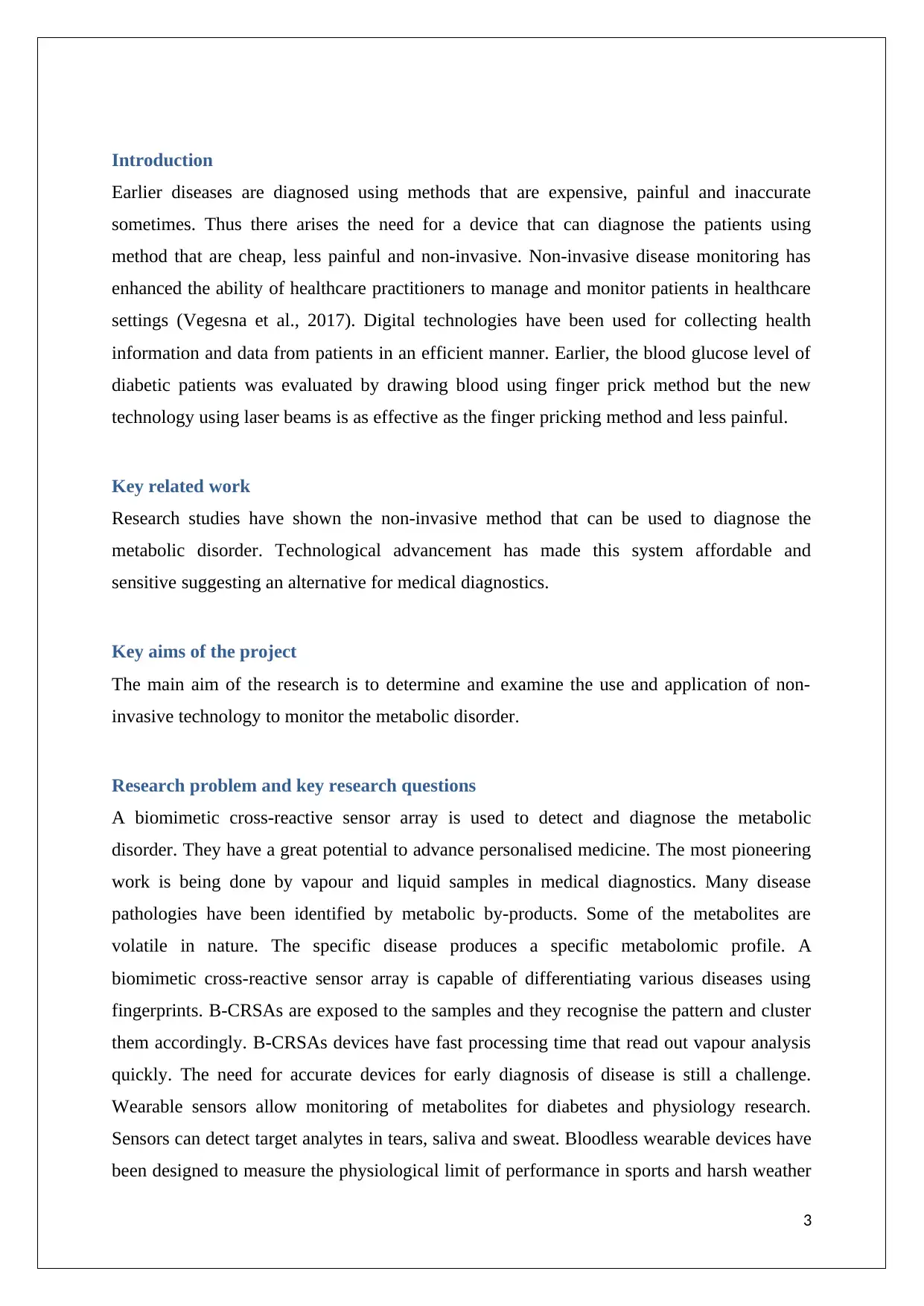
Introduction
Earlier diseases are diagnosed using methods that are expensive, painful and inaccurate
sometimes. Thus there arises the need for a device that can diagnose the patients using
method that are cheap, less painful and non-invasive. Non-invasive disease monitoring has
enhanced the ability of healthcare practitioners to manage and monitor patients in healthcare
settings (Vegesna et al., 2017). Digital technologies have been used for collecting health
information and data from patients in an efficient manner. Earlier, the blood glucose level of
diabetic patients was evaluated by drawing blood using finger prick method but the new
technology using laser beams is as effective as the finger pricking method and less painful.
Key related work
Research studies have shown the non-invasive method that can be used to diagnose the
metabolic disorder. Technological advancement has made this system affordable and
sensitive suggesting an alternative for medical diagnostics.
Key aims of the project
The main aim of the research is to determine and examine the use and application of non-
invasive technology to monitor the metabolic disorder.
Research problem and key research questions
A biomimetic cross-reactive sensor array is used to detect and diagnose the metabolic
disorder. They have a great potential to advance personalised medicine. The most pioneering
work is being done by vapour and liquid samples in medical diagnostics. Many disease
pathologies have been identified by metabolic by-products. Some of the metabolites are
volatile in nature. The specific disease produces a specific metabolomic profile. A
biomimetic cross-reactive sensor array is capable of differentiating various diseases using
fingerprints. B-CRSAs are exposed to the samples and they recognise the pattern and cluster
them accordingly. B-CRSAs devices have fast processing time that read out vapour analysis
quickly. The need for accurate devices for early diagnosis of disease is still a challenge.
Wearable sensors allow monitoring of metabolites for diabetes and physiology research.
Sensors can detect target analytes in tears, saliva and sweat. Bloodless wearable devices have
been designed to measure the physiological limit of performance in sports and harsh weather
3
Earlier diseases are diagnosed using methods that are expensive, painful and inaccurate
sometimes. Thus there arises the need for a device that can diagnose the patients using
method that are cheap, less painful and non-invasive. Non-invasive disease monitoring has
enhanced the ability of healthcare practitioners to manage and monitor patients in healthcare
settings (Vegesna et al., 2017). Digital technologies have been used for collecting health
information and data from patients in an efficient manner. Earlier, the blood glucose level of
diabetic patients was evaluated by drawing blood using finger prick method but the new
technology using laser beams is as effective as the finger pricking method and less painful.
Key related work
Research studies have shown the non-invasive method that can be used to diagnose the
metabolic disorder. Technological advancement has made this system affordable and
sensitive suggesting an alternative for medical diagnostics.
Key aims of the project
The main aim of the research is to determine and examine the use and application of non-
invasive technology to monitor the metabolic disorder.
Research problem and key research questions
A biomimetic cross-reactive sensor array is used to detect and diagnose the metabolic
disorder. They have a great potential to advance personalised medicine. The most pioneering
work is being done by vapour and liquid samples in medical diagnostics. Many disease
pathologies have been identified by metabolic by-products. Some of the metabolites are
volatile in nature. The specific disease produces a specific metabolomic profile. A
biomimetic cross-reactive sensor array is capable of differentiating various diseases using
fingerprints. B-CRSAs are exposed to the samples and they recognise the pattern and cluster
them accordingly. B-CRSAs devices have fast processing time that read out vapour analysis
quickly. The need for accurate devices for early diagnosis of disease is still a challenge.
Wearable sensors allow monitoring of metabolites for diabetes and physiology research.
Sensors can detect target analytes in tears, saliva and sweat. Bloodless wearable devices have
been designed to measure the physiological limit of performance in sports and harsh weather
3
Paraphrase This Document
Need a fresh take? Get an instant paraphrase of this document with our AI Paraphraser
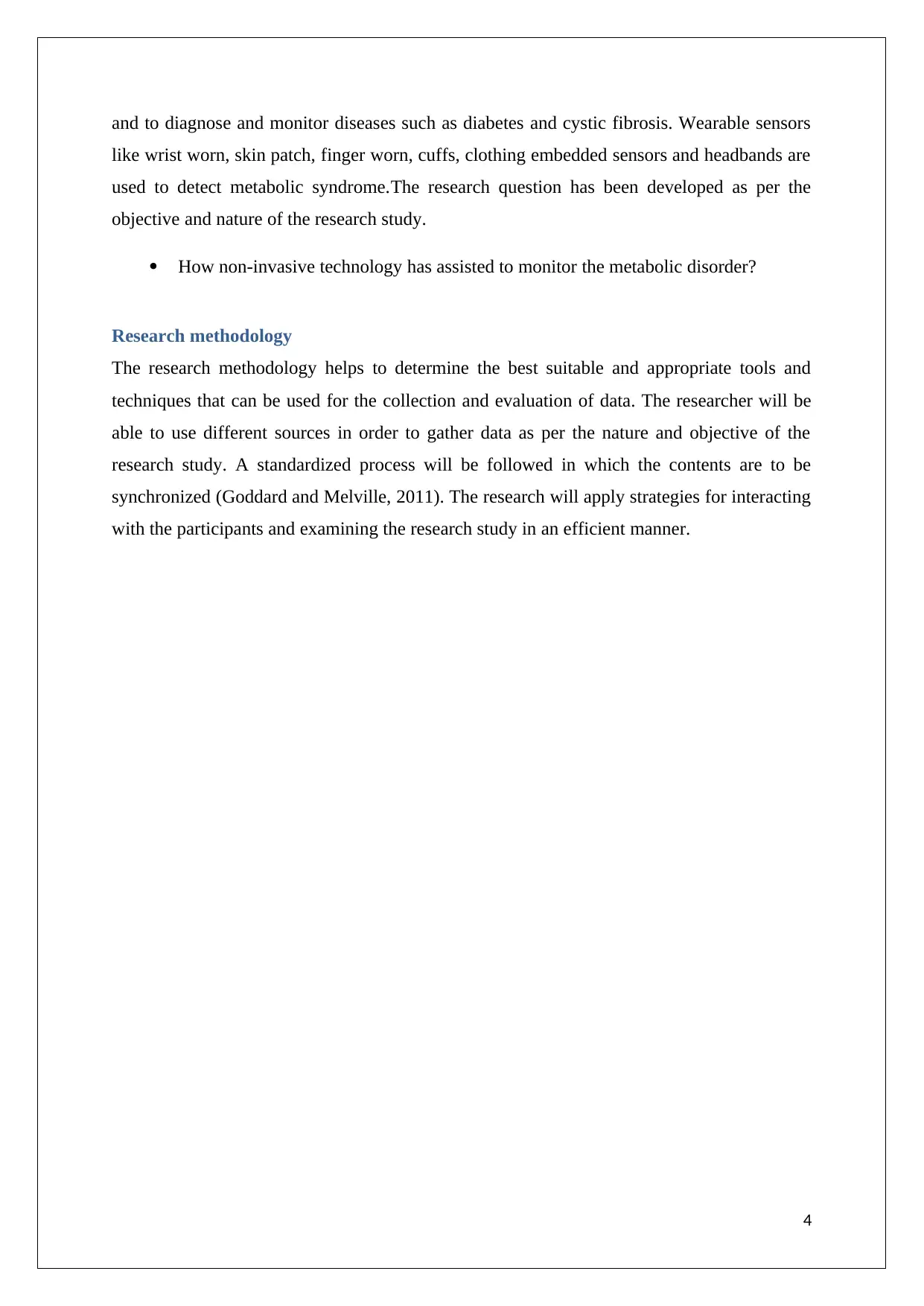
and to diagnose and monitor diseases such as diabetes and cystic fibrosis. Wearable sensors
like wrist worn, skin patch, finger worn, cuffs, clothing embedded sensors and headbands are
used to detect metabolic syndrome.The research question has been developed as per the
objective and nature of the research study.
How non-invasive technology has assisted to monitor the metabolic disorder?
Research methodology
The research methodology helps to determine the best suitable and appropriate tools and
techniques that can be used for the collection and evaluation of data. The researcher will be
able to use different sources in order to gather data as per the nature and objective of the
research study. A standardized process will be followed in which the contents are to be
synchronized (Goddard and Melville, 2011). The research will apply strategies for interacting
with the participants and examining the research study in an efficient manner.
4
like wrist worn, skin patch, finger worn, cuffs, clothing embedded sensors and headbands are
used to detect metabolic syndrome.The research question has been developed as per the
objective and nature of the research study.
How non-invasive technology has assisted to monitor the metabolic disorder?
Research methodology
The research methodology helps to determine the best suitable and appropriate tools and
techniques that can be used for the collection and evaluation of data. The researcher will be
able to use different sources in order to gather data as per the nature and objective of the
research study. A standardized process will be followed in which the contents are to be
synchronized (Goddard and Melville, 2011). The research will apply strategies for interacting
with the participants and examining the research study in an efficient manner.
4
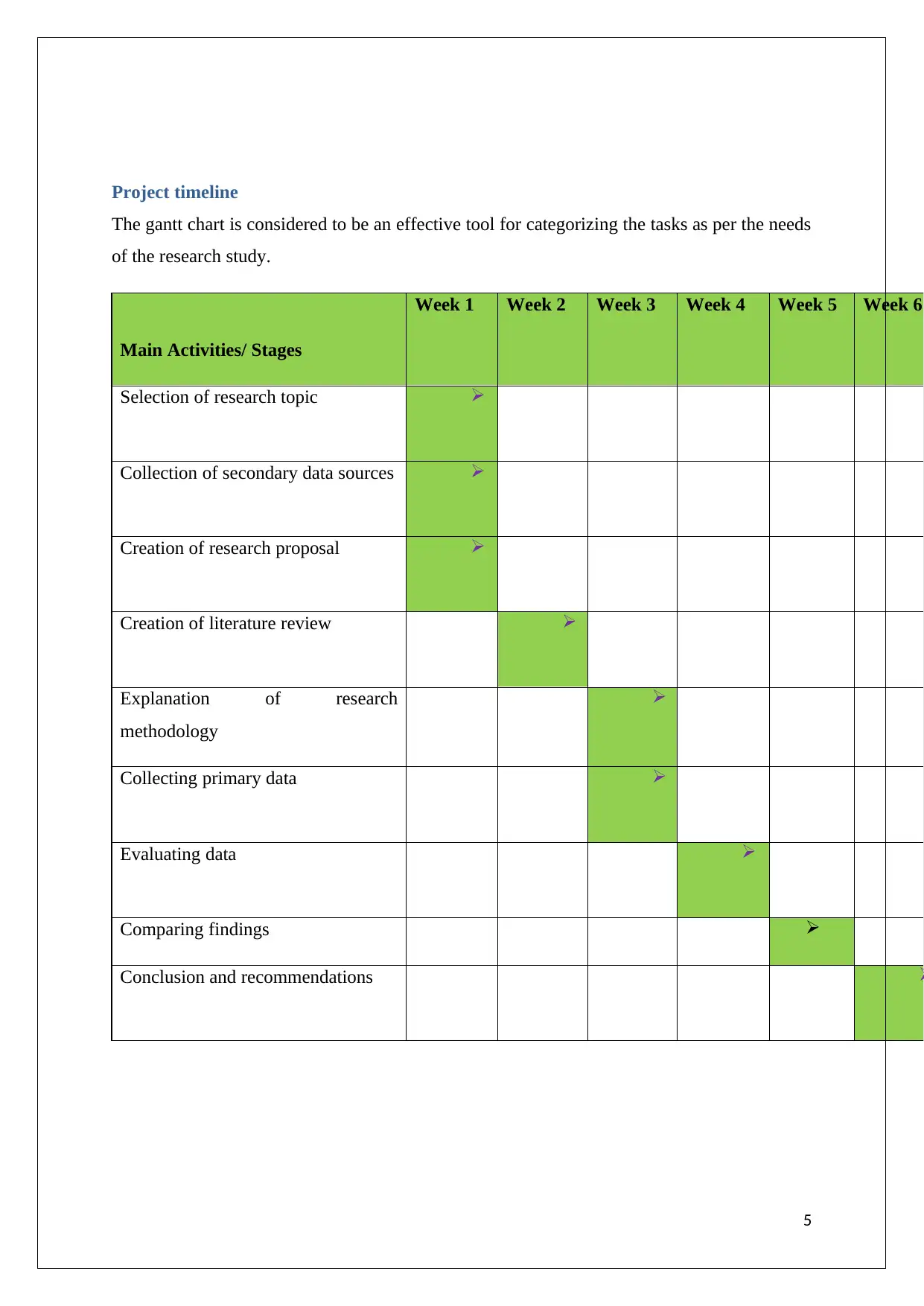
Project timeline
The gantt chart is considered to be an effective tool for categorizing the tasks as per the needs
of the research study.
Main Activities/ Stages
Week 1 Week 2 Week 3 Week 4 Week 5 Week 6
Selection of research topic
Collection of secondary data sources
Creation of research proposal
Creation of literature review
Explanation of research
methodology
Collecting primary data
Evaluating data
Comparing findings
Conclusion and recommendations
5
The gantt chart is considered to be an effective tool for categorizing the tasks as per the needs
of the research study.
Main Activities/ Stages
Week 1 Week 2 Week 3 Week 4 Week 5 Week 6
Selection of research topic
Collection of secondary data sources
Creation of research proposal
Creation of literature review
Explanation of research
methodology
Collecting primary data
Evaluating data
Comparing findings
Conclusion and recommendations
5
⊘ This is a preview!⊘
Do you want full access?
Subscribe today to unlock all pages.

Trusted by 1+ million students worldwide
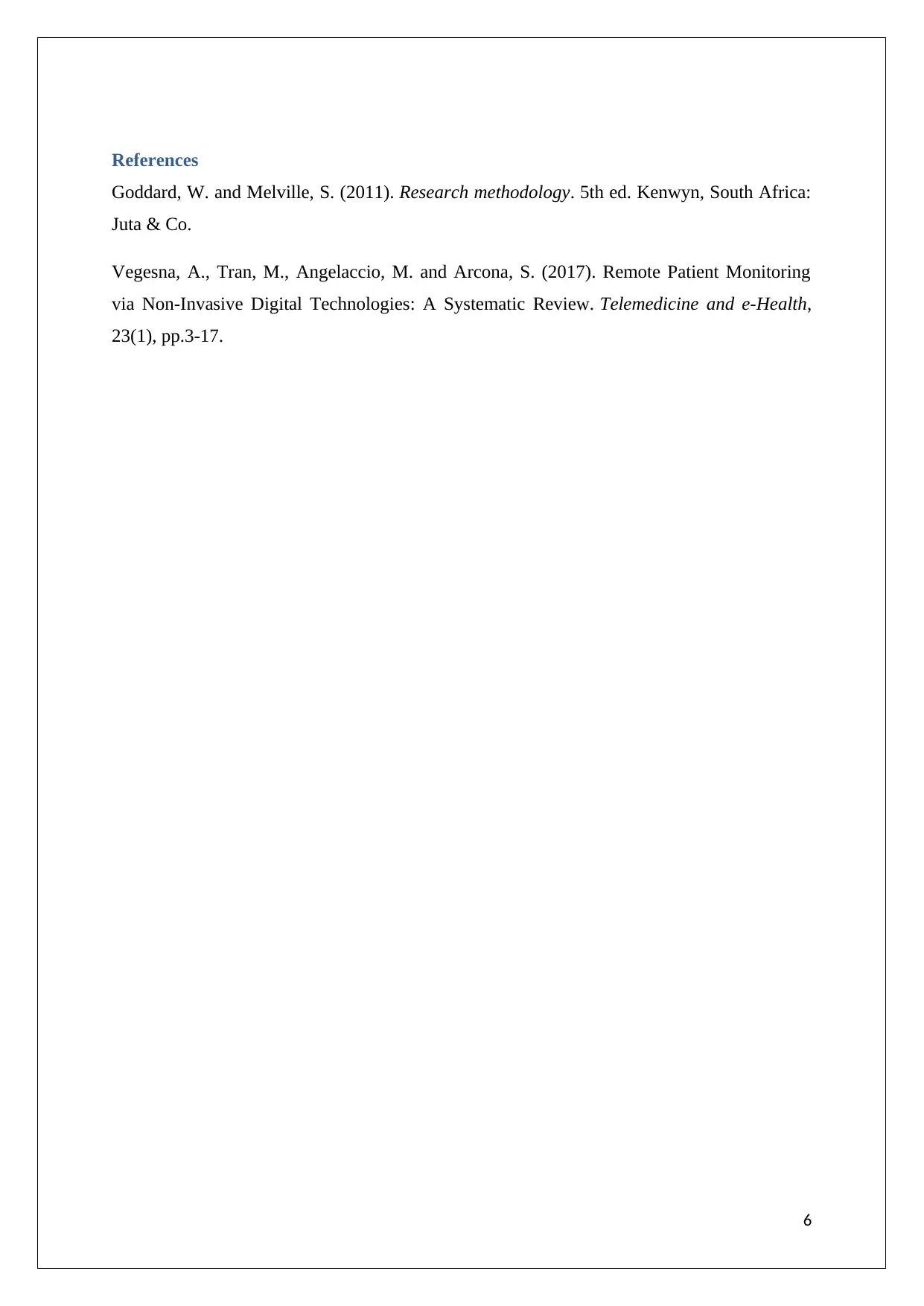
References
Goddard, W. and Melville, S. (2011). Research methodology. 5th ed. Kenwyn, South Africa:
Juta & Co.
Vegesna, A., Tran, M., Angelaccio, M. and Arcona, S. (2017). Remote Patient Monitoring
via Non-Invasive Digital Technologies: A Systematic Review. Telemedicine and e-Health,
23(1), pp.3-17.
6
Goddard, W. and Melville, S. (2011). Research methodology. 5th ed. Kenwyn, South Africa:
Juta & Co.
Vegesna, A., Tran, M., Angelaccio, M. and Arcona, S. (2017). Remote Patient Monitoring
via Non-Invasive Digital Technologies: A Systematic Review. Telemedicine and e-Health,
23(1), pp.3-17.
6
1 out of 7
Your All-in-One AI-Powered Toolkit for Academic Success.
+13062052269
info@desklib.com
Available 24*7 on WhatsApp / Email
![[object Object]](/_next/static/media/star-bottom.7253800d.svg)
Unlock your academic potential
Copyright © 2020–2025 A2Z Services. All Rights Reserved. Developed and managed by ZUCOL.

